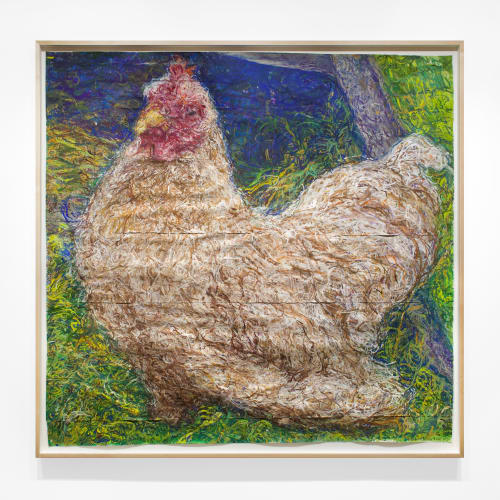Inman Gallery is pleased to present Beth Secor: The Solace Found in Sentience, the artist’s eighth solo show at Inman Gallery since 1993. The show features a debut group of paintings on paper completed within the past three years, alongside select earlier works that keep with the artist’s focus on nature, to present a wholistic overview of the artist’s practice over the past decade. Included are intimate portraits of trees, flowers, and animals, each individualistic in their rendering to capture the subject’s specificity and personality. Collectively, the works form a lush and vibrant ecosystem, containing towering pecan trees, stoic sparrows, bursting sunflowers, smug chickens, and skeptical housecats. In these works, Secor invites the viewer to closely observe and celebrate the natural abundance of our landscape, offering comfort, empathy, and renewal as a result of a viewer’s connection to the natural world.
Secor’s artistic process is meticulous, meditative and time intensive. She begins by drawing on a single sheet of paper, adding multiple pages to expand the work’s scale as it reveals itself through her making. The resulting artwork is often a “construct” of multiple pages, the history of the work’s creation visible through the seams on the work’s surface.
While Secor’s distinct, painterly mark-making and interest in nature echo the looser brushwork and subject matter characteristic of the artistic movements dominant in the 19th century, such as Naturalism or Impressionism, her fearless use of color and energetic mark-making align her more closely with the later Modernists, recalling the gestural movement of Action Painting with the vibrant color palette of Fauvism. Appropriately, the palpable energy and vibrancy of her paintings echo the rhythm of the natural environment in which her subjects are found.
Furthermore, her vibrant brushwork and choice of subject matter resonate with a profound sense of emotion that is rooted in the collective grief of this current historic moment. On her recent paintings created in the wake of the pandemic, Secor notes:
“When people die, we place flowers on their grave. Flowers represent the temporal nature of life, but they also represent how beautiful and wonderful it can be, even though it is fleeting. At the risk of sounding trite, we should all hand out flowers to our loved ones, while they are still alive.”
The works on view in this exhibition recognize grief as an engulfing presence that demands to be felt in order to be alleviated, and offer a comforting yet lively space for the viewer to do so. There is an undeniable optimism to Secor’s works, a resilience and profound sense of hope that can be found in the natural life cycles of a world otherwise turned upside down. Secor wisely wrote that that “over the years, I came to the realization that trees are living, breathing, sentient beings. As a child I bore witness to their suffering,” recalling lightning strikes, or fires, or insect infestations in the wood. Inversely, in these works it is the natural world — the trees, the animals, the flowers — who collectively bear witness to our own suffering, solacing us with the promise of renewal in the coming of spring.

